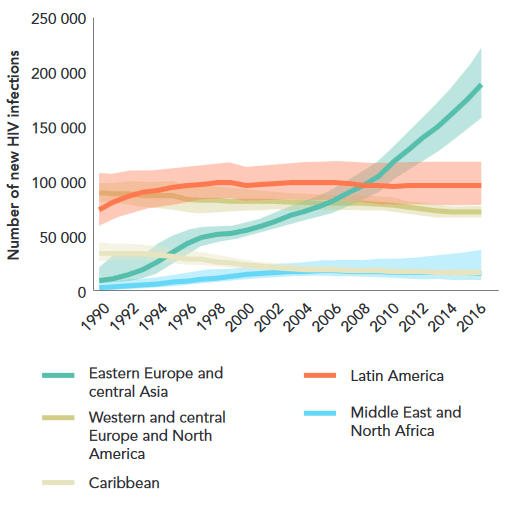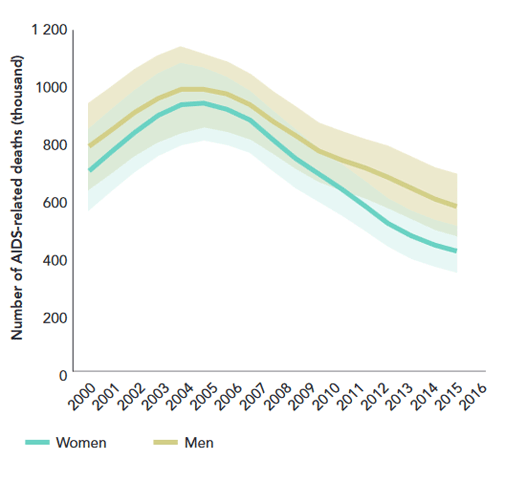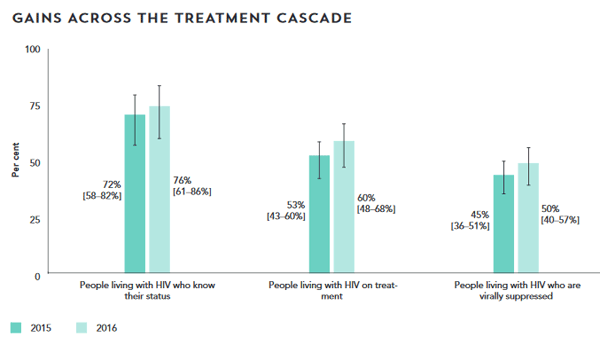


Acquired Immune Deficiency Syndrome (AIDS) is a disease due to infection by the Human Immunodeficiency Virus (HIV). It is spread primarily by unprotected sex including anal and oral sex, contaminated blood transfusions, hypodermic needles, and from mother to child during pregnancy, delivery, or breastfeeding.
In 2016, the world adopted the United Nations Political Declaration on Ending AIDS. This snapshot of the HIV epidemic shows country by country where we are in this commitment to end AIDS as a public health threat by 2030, and shows how far we have come and we have to go as even with the advances of antiretroviral therapy, AIDS is still a leading cause of death.
UNAIDS annually provides revised global, regional and country-specic modelled estimates using the best available epidemiological and programmatic data to track the HIV epidemic. Modelled estimates are required because it is impossible to count the exact number of people living with HIV, people who are newly infected with HIV or people who have died from AIDS-related causes in any country: doing so would require regularly testing every person for HIV and investigating all deaths, which is logistically impossible and ethically problematic.
After the peak of new cases in the late 90’s the number of new HIV infections has declined steadily. The number of people living with the virus has continued to grow steadily as they now live longer with HIV.
In 2016, it is estimated that 37 million people worldwide live with HIV, a number which includes 18 million women and 2 million children. The number of newly infected people that year was 1.8 million, and the number of deaths caused by AIDS was 1.0 million.
There are thus about 5000 new HIV infections per day, and two thirds of those are in sub-Saharan Africa, which remains the most heavily affected area, with more than 25 million people living with HIV and 700 000 deaths each year from AIDS in this region alone.
Global efforts to strengthen HIV prevention and treatment programmes are reducing the transmission of HIV. Since 2010, the annual number of new HIV infections (all ages) has declined by 16% to 1.8 million. This is much slower than expected to meet the 2020 target of less than 500 000 new infections per year.
The pace of decline varied by age group and between men and women:
Regional trends in the annual number of new HIV infections for people of all ages also varied. The steepest declines between 2010 and 2016 were achieved in eastern and southern Africa (29% decline), followed by Asia and the Pacific (13% decline), western and central Africa (9% decline), western and central Europe and North America (9% decline), the Caribbean (5% decline), and the Middle East and North Africa (4% decline).
Trends over the same time period in Latin America were stable, but in eastern Europe and central Asia, the annual number of new infections climbed by an alarming 60%.

Since 2005, the number of deaths caused by AIDS has declined from a maximum of almost 2 million deaths in 2005, down to 1 million in 2016. This is due to the efficient anti-retroviral therapy made more available around the world. The decline has been faster among women, since they have higher treatment coverage and tend to better adhere to treatment: deaths from AIDS-related illnesses were 27% lower among women and girls in 2016 than they were among men and boys.
Nonetheless, in Africa, AIDS-related illnesses remain the leading cause of death among women of reproductive age (15–49 years) globally and they are the second leading cause of death for young women aged 15–24 years.

In 2016, the number of children (aged 0–14 years) dying of AIDS-related illnesses has been nearly cut in half in just six years, from 210 000 in 2010 to 120 000. Much of the decline is due to steep reductions in new HIV infections among children, with increased access to pediatric antiretroviral therapy also playing an important role.
Globally between 2010 and 2016, acceleration of the AIDS response has reduced AIDS-related deaths by 32% and new HIV infections by 16%:
Meanwhile, worrying increases in AIDS-related mortality have occurred over the past decade in the Middle East and North Africa (48% increase) and in eastern Europe and central Asia (38% increase).
In areas where there are a lot of people infected, young women remain at unacceptably high risk of HIV infection. In eastern and southern Africa, for example, young women (aged 15–24 years) accounted for 26% of new HIV infections in 2016 despite making up only 10% of the population. In 2016, young women (aged 15–24 years accounted for 22% and17% of new HIV infections in western and central Africa and the Caribbean, respectively.
In lower prevalence settings, the majority of HIV infections occur among key populations: people who inject drugs, sex workers, transgender people, prisoners, and gay men and other men who have sex with men and their sexual partners. Globally, gay men and other men who have sex with men accounted for 12% of new infections in 2015, while sex workers and people who inject drugs accounted for 5% and 8% of new infections, respectively. Furthermore, data reported by countries across the world show that HIV prevalence among key populations is often substantially higher than it is among than the general population.
Outside sub-Saharan Africa, key populations and their sexual partners accounted for 80% of new HIV infections in 2015. Even in sub-Saharan Africa, key populations and their sexual partners are an important part of the HIV epidemic: in 2015, 25% of new infections occurred among this group, underlining the importance of reaching them with services.
In 2016, the Joint United Nations Programme on HIV and AIDS (UNAIDS) has set out to reach by 2020 the “90-90-90” target for treatment of the AIDS epidemic. This means that more than 90% of people living with HIV should know their status, more than 90 % of those are treated, and 90% or those who are treated should have suppressed viral loads.
UNAIDS annually provides revised global, regional and country-specific modelled estimates using the best available epidemiological and programmatic data to track the HIV epidemic. The data needed to assess this are not yet available for all countries, but progress is being made, with 76 countries in 2016 having access to data for all three targets, an increase over just the preceding year, where only 55 countries had that data.
UNAIDS is confident that the actual numbers of people living with HIV, who are newly infected with HIV or who have died from AIDS-related causes, lie within the reported ranges. Over time, more and better data from countries will steadily reduce uncertainty.
It is an ambitious target, with some regions lagging far behind, like in western and central Africa, where it is estimated that only 42% of people infected know their HIV status.


This summary is free and ad-free, as is all of our content. You can help us remain free and independant as well as to develop new ways to communicate science by becoming a Patron!